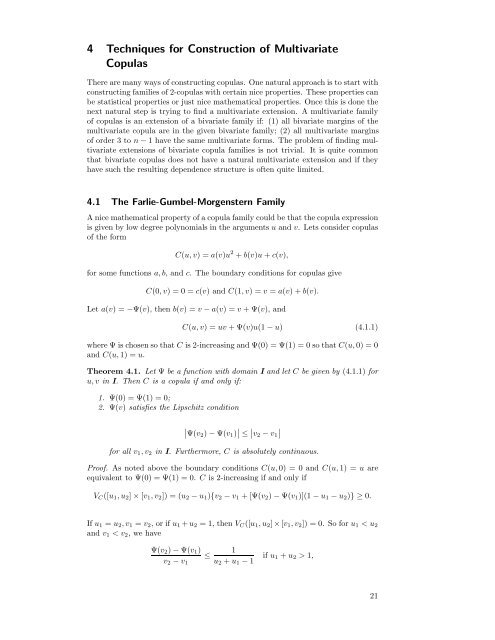Modelling Dependence with Copulas - IFOR
Modelling Dependence with Copulas - IFOR
Modelling Dependence with Copulas - IFOR
You also want an ePaper? Increase the reach of your titles
YUMPU automatically turns print PDFs into web optimized ePapers that Google loves.
4 Techniques for Construction of Multivariate<br />
<strong>Copulas</strong><br />
There are many ways of constructing copulas. One natural approach is to start <strong>with</strong><br />
constructing families of 2-copulas <strong>with</strong> certain nice properties. These properties can<br />
be statistical properties or just nice mathematical properties. Once this is done the<br />
next natural step is trying to find a multivariate extension. A multivariate family<br />
of copulas is an extension of a bivariate family if: (1) all bivariate margins of the<br />
multivariate copula are in the given bivariate family; (2) all multivariate margins<br />
of order 3 to n − 1 have the same multivariate forms. The problem of finding multivariate<br />
extensions of bivariate copula families is not trivial. It is quite common<br />
that bivariate copulas does not have a natural multivariate extension and if they<br />
have such the resulting dependence structure is often quite limited.<br />
4.1 The Farlie-Gumbel-Morgenstern Family<br />
A nice mathematical property of a copula family could be that the copula expression<br />
is given by low degree polynomials in the arguments u and v. Lets consider copulas<br />
of the form<br />
C(u, v) =a(v)u 2 + b(v)u + c(v),<br />
for some functions a, b, and c. The boundary conditions for copulas give<br />
C(0,v)=0=c(v) andC(1,v)=v = a(v)+b(v).<br />
Let a(v) =−Ψ(v), then b(v) =v − a(v) =v +Ψ(v), and<br />
C(u, v) =uv +Ψ(v)u(1 − u) (4.1.1)<br />
where Ψ is chosen so that C is 2-increasing and Ψ(0) = Ψ(1) = 0 so that C(u, 0) = 0<br />
and C(u, 1) = u.<br />
Theorem 4.1. Let Ψ be a function <strong>with</strong> domain I and let C be given by (4.1.1) for<br />
u, v in I. Then C is a copula if and only if:<br />
1. Ψ(0) = Ψ(1) = 0;<br />
2. Ψ(v) satisfies the Lipschitz condition<br />
∣ Ψ(v2 ) − Ψ(v 1 ) ∣ ∣ ≤<br />
∣ ∣v2 − v 1<br />
∣ ∣<br />
for all v 1 ,v 2 in I. Furthermore, C is absolutely continuous.<br />
Proof. As noted above the boundary conditions C(u, 0) = 0 and C(u, 1) = u are<br />
equivalent to Ψ(0) = Ψ(1) = 0. C is 2-increasing if and only if<br />
V C ([u 1 ,u 2 ] × [v 1 ,v 2 ]) = (u 2 − u 1 ){v 2 − v 1 +[Ψ(v 2 ) − Ψ(v 1 )](1 − u 1 − u 2 )}≥0.<br />
If u 1 = u 2 ,v 1 = v 2 , or if u 1 + u 2 =1,thenV C ([u 1 ,u 2 ] × [v 1 ,v 2 ]) = 0. So for u 1
















